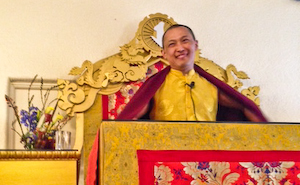Friday
Dharma TeachingsInvestigating Motivation
by Sakyong Mipham Rinpoche
In Buddhism, it is motivation that defines us what kind of practitioner we are. Simply put, the greater our motivation on the path, the greater our potential.
Traditionally, there are said to be three kinds of motivation: small, medium, and large. Within the small, there are three categories: the small of the small, the middle of the small, and the great of the small. This is also a way of describing our evolution as practitioners, and a teaching about how we relate to our lives.
There is motivation in whatever we do. In general, small motivation is when our goal is simply to be happy and content in this lifetime. When this is our motivation, we are not particularly concerned about what happened before we were born or what happens after we die. Our goal is simply to make ourselves comfortable in this lifetime.
If our motivation is the small of the small, we are worldly people who are not engaged in a spiritual path of any kind. The world is the way it is, and there is no need for further exploration. We’re here and we’re going to try to have a good life. Our thinking revolves around getting what we want, and we use purely worldly means to make ourselves content and happy.
If our motivation is a little bigger than that — the middling of the small — we add some spiritual elements to the project of making ourselves content. Some interest or faith arises: perhaps happiness is deeper than just getting what we want from the world. There is something about hearing spiritual teachings that quenches our thirst, so we turn our mind in that direction. However, our basic motivation is still wanting to be satisfied in this life, and we are very much interested in worldly endeavors.
People with the large of the small motivation operate within the same basic framework — we are primarily interested in personal happiness. However, we’ve seen the pitfalls of samsara. We’ve discovered that on the wheel of suffering, all our attempts to make ourselves happy are thwarted. Passing through one relationship after another, being sick, losing friends and family to death — all these have opened our eyes. And we realize it’s not just us. Pain, suffering, and karma are the basic nature of samsara.
At this point we are starting to be concerned about the next lifetime. We see there is more to life than just satisfying our immediate desires. We think, “At first I just cared about this lifetime, but maybe there’s something more than that. If that’s true, maybe I should start practicing. If I am the product of a previous lifetime, maybe I should do something now that will benefit future lifetimes.” We do not want to plant bad karmic seeds, so we stop creating situations that take us in that direction. We no longer denigrate our mind and body, or cause harm to others.
At this point we have entered the medium motivation. The cyclic nature of samsara has taught us a few lessons. It’s not that samsara is always bad, but it goes on forever. Things may be good for awhile, but then they get worse, so the mind can never really rest. So we are intent on getting out of that cycle. We understand that it inevitably brings pain, and we seek liberation from the round of birth and death. However, at this stage we do not care for others in the way that we care for ourselves. We see suffering, we have renunciation, and we seek liberation — but only for ourselves.
Finally, we have great motivation. Seeing that all sentient beings suffer in the same ways that we do, we seek release from the misery of cyclic existence not only for ourselves but for them as well. We realize that only people who are free from confusion themselves can help others achieve ultimate happiness. We take the welfare of all beings as our responsibility. We strive for unsurpassed enlightenment as the means to bring about that same enlightenment in all sentient beings. This is the view, meditation, and conduct of the Mahayana. This motivation is what it means to be a bodhisattva.
In this culture it can be hard for us to believe in the reality of multiple lifetimes. However, we can ask ourselves, “What if it is true?” Exploring the possibility of past and future lifetimes begins to shift how we look at things. We see how expansive the mind can be. We have seen the horrors of samsara, and the whole situation has become very vivid. We ask ourselves, “Where am I coming from? What do I think is real? Do I think samsara is real, and do I really think it is going to last forever?” Unless we ask questions like this now, we won’t know what to believe at the moment of death. So we turn our mind toward doing something in this lifetime that will help the next life.
In meditation there’s sometimes a tendency to regard thinking as no good. However, contemplative meditation, in which we focus on particular concepts such as karma or suffering, can change how we think, literally. By contemplating motivation, we slowly but surely change our mental and emotional approach to what we are trying to accomplish in life. If we get up from our meditation session and find nothing has changed, we have to ask ourselves if we are doing the practice correctly. There is no point to practice if we continue thinking in the same way.Since we’re bound to be thinking anyway, we might as well be thinking about motivation. That can be very constructive, because as we contemplate our motivation, it grows bigger. The bigger the motivation, the bigger our heart and mind become. As our motivation grows, we become less speedy, less needy, less determined; we’re a little less worried about everything going wrong. We’re able to help others. Whether we believe in past and future lifetimes or not, it is always true that the bigger the motivation, the greater our potential for true happiness.
~~
Learn more about Sakyong Mipham Rinpoche here: www.sakyong.com
Read this article in Spanish (thanks to Luz Rodriguez!).



















Sep 8, 2014
Reply
A useful way to define a desirable path to take and the goals to be strived for at various levels. Also one can be a positive force for change within oneself and also for others at whatever level one finds ones self. The
bodhisattva path is experienced at all levels and one can be a positive force in the present moment rather
than waiting for some exalted future evolution.